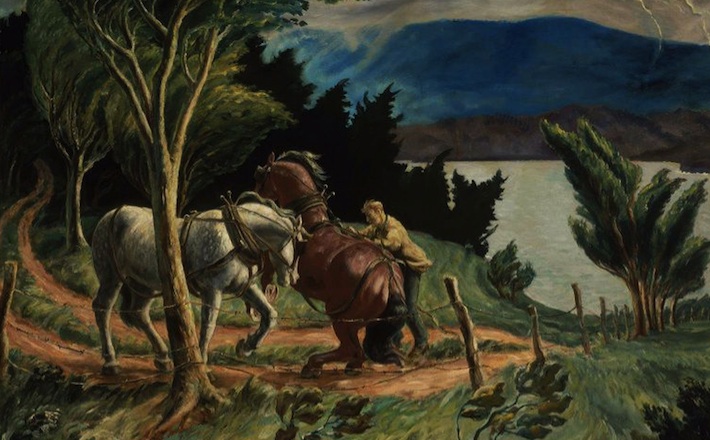Commentary on Isaiah 53:4-12
Whereas discussion of Israel’s role as God’s servant is one of several key themes in Isaiah 40-48, a new pattern emerges with chapter 49.
There Servant Israel himself is represented as speaking for the first time, reflecting on God’s call and his own internal struggles, and accepting God’s commission (compare, for instance, Isaiah 42:6 and 49:6). (For this passage’s context in the sixth century BCE and in Isaiah 40-55’s discussions of God’s servant, see my commentary on Isaiah 50:4-9a on September 13, 2015.)
From that point on, attention alternates in Isaiah 49-54 between the servant, who in the context of chapters 40-48 continues to represent Israel, or at least the Israel the prophet believes the nation is called to become, and the city of Jerusalem, personified as Daughter Zion, who has suffered terrible devastation and is reassured by God of her coming transformation. With this alternating attention the prophet carefully weaves Jerusalem’s imagined redemption, and a role in Jerusalem for returning exiles. Although Isaiah 52:13-53:12 is the book’s final major “servant” passage, the next chapter concludes with mention, for the first time, of the “servants of the LORD” within Zion (v. 17). These plural servants, the actual faithful, reappear frequently in chapters 56-66.
Unlike the previous two servant passages, but like Isaiah 42 and 50:10-11, this passage doesn’t quote Servant Israel’s own speech, but rather discusses him in third person, describing in rather oblique terms certain aspects of his suffering and its evaluation by humans and God. The speaker represents a plural group, a “we” who are reassessing the servant, passing from disdain to admiration and awe. As before, the servant’s call is to wide justice, even reaching foreign nations (see Isaiah 42:1, 4; 49:6-7; 52:15). The plural witnesses beginning in 53:1 seem most clearly to represent the startled nations themselves.
Isaiah 53:4-12 presents careful exegetes a number of difficulties:
- Although 52:13-53:12 is a unit (cf. the annual Good Friday reading), for some reason the lectionary here begins with 53:4, commencing midway through the “we” speech.
- The passage is riddled with textual difficulties, translational dilemmas, and interpretive ambiguities, conferring on the poem both mystique and confusion.
- The passage’s clearest theme, theological exploration of the problem of vicarious suffering and God’s role in inflicting such suffering, is itself beset with moral and religious problems.
- Sadly, the passage’s history of interpretation exemplifies, or rather trumpets, the painful story of Christian persecution of Jews, especially in the middle ages, a history that betrays the passage’s own noble themes. Though it does not commend triumph against others, but faithfulness on others’ behalf, it has been wielded since the second century as a weapon of interfaith strife, “proof” that Jews who read Isaiah 53 non-Christologically are deaf to their own prophets.
- Although this passage was not composed for Christians any more than preachers today would occupy ourselves with the year 2600, the lectionary places it only in the context of Jesus’ crucifixion, reinforcing traditional Christian reading of Isaiah as herald of Christ. Even in ordinary time it is juxtaposed with Mark’s allusive declaration, “For the Son of Man came not to be served but to serve, and to give his life a ransom for many” (Mark 10:45; cf. Isaiah 53:11).
Let’s parse these difficulties:
- The lectionary choice is indeed problematic. As the repetition of three thematic words in both verses 3 and 4 shows (mah’ov, “suffering”/“diseases”; holi, “infirmity”; hashav, “accounted, reckoned”), commencing with verse 4 breaks into the middle of the contrast between what the speakers had thought and what they have come to think. Preachers may choose either to read the whole passage or to offer a synopsis of what precedes.
- The seventeen textual notes appearing in the Biblia Hebraica Stuttgartensia (BHS) for these nine verses only scratch the surface of translational dilemmas. Accomplished exegetes disagree on key points, such as whether the servant is portrayed as having died. Some of the passage’s mystique may be intentional, but the rest is simply too inscrutable for anyone to justify making dogma from Isaiah 53’s details. Yet we can perceive the broad outline.
- The problem of unjust suffering recurs in Scripture from the story of Abel onward. Its underlying theology is parsable, but not lightly resolved. On the one hand, the claim found in Exodus 20:5 (cf. 34:7; Numbers 14:18; Deuteronomy 5:9; passim) that God punishes children and grandchildren for their forebears’ sins meets justifiable outrage. But, on the other hand, the solution proposed by Jeremiah and Ezekiel that “it is only the person who sins that shall die” (Ezekiel 18:4; cf. Jeremiah 31:30) stands counter to lived experience, both ancient and modern.
The speakers’ initial assessment, dismissing the servant’s pain, shares assumptions promoted in 1-2 Kings and Proverbs that people suffer justly for their own sins. There’s truth there, of course. But other biblical literature, notably lament psalms and Job, drives a realistic wedge between guilt and suffering.
The speakers’ reassessment in Isaiah 53:7 takes the discussion several steps farther. It confers purpose and grace on the servant’s righteous suffering by drawing analogies to the sacrificial lamb, which in the temple system of atonement suffered punishment that rightly belonged to its human presenter. But unlike the unfortunate lamb, the servant voluntarily bears others’ sins, choosing not justice but costly compassion.
- While finding meaning and dignity in bearing others’ sins shows remarkable grace, Christian history has been badly marred by those inflicting suffering on others. We can hope the bad old days of inquisitions, antisemitic passion plays, and forced conversions are gone for good. Yet even — and sometimes especially — Christians have not yet finished afflicting people who look, live, or believe differently from ourselves. As sinners, we will inevitably both suffer and inflict suffering. But those who choose to bear others’ loads without judgment will be called peacemakers and children of God.
- It is virtually impossible for Christians to read the servant without seeing Jesus. Preachers can, however, choose how we associate Isaiah 53 with him. New Testament allusions to this passage abound, demonstrating its importance for first-century writers seeking to interpret Christ. The book of Romans is arguably a tour de force inspired by this passage and others, and much of the imagery of the Gospel passion narratives springs from Isaiah 53 alongside Psalm 22.
But the most direct allusions are found in the story of the Ethiopian eunuch who reads this passage with Philip (Acts 8:27-39) and the exhortation to slaves in 1 Peter 2:18-25 to follow Jesus’ example. Both passages begin from the springboard of unjust existential suffering, whether of unnamed slaves or of a maimed and marred African official. Both passages seek to confer dignity on painful experience. In the last instance, Isaiah 53 is not about Jesus or Moses or even Israel: it’s about us, about how we too bear the sins of many and intercede for transgressors (v. 12). In an age of “me” and “my rights” this is not a popular idea, but in the calculus of inevitable human misdeeds it’s a necessary one. Not for preaching to others first, but for living ourselves.
If the prophet was setting forth a model of faithful Israelite service, then any Jew who sought to emulate that pattern would resemble this servant. Jesus is a Jew whose life and death model such integrity, and who for us gentiles offers a doorway into biblical faith. If we can seek to emulate the servant’s faithfulness, and that of Jesus himself, in choosing to bear others’ sins, we will be reading Isaiah 53 for all it is worth.


October 18, 2015